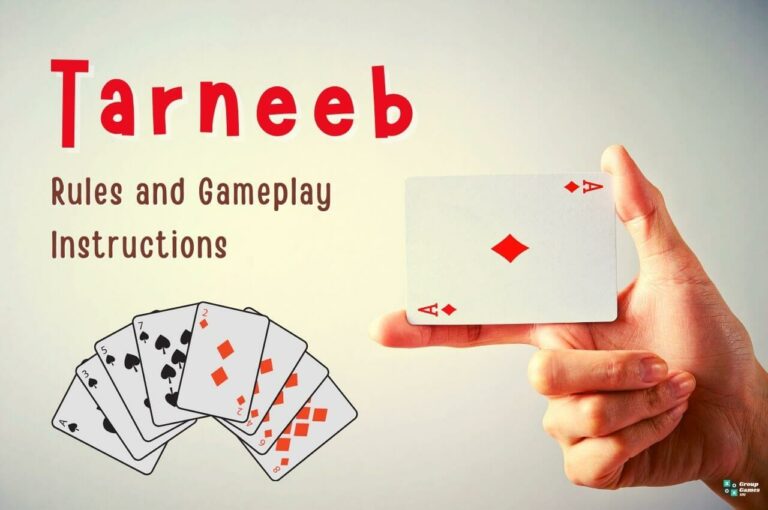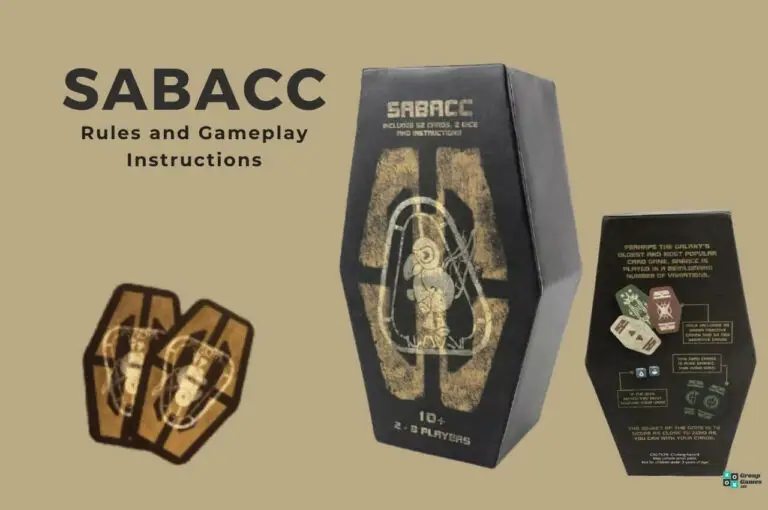Are you seeking a card game that will test your focus and strategic skills? This Bridge card game rules guide will teach you how to play one.
Bridge, also known as Contract Bridge, is a classic trick-taking card game dating back to the 19th century. Traditionally, it’s played by two competing teams of two players each.
Historically, the Bridge rules evolved from the rules of the Whist card game, so the two have a lot in common. The game is also quite similar to Spades (see Spades card game rules).
Key highlights of this Bridge card game rules guide:
- What is Bridge
- Bridge Card Game Rules
- Bridge Scoring
- Bridge Card Game Rules in Pictures
- How to play Bridge (Video tutorial)
Read on for step-by-step instructions on how to play Bridge.
What is Bridge?
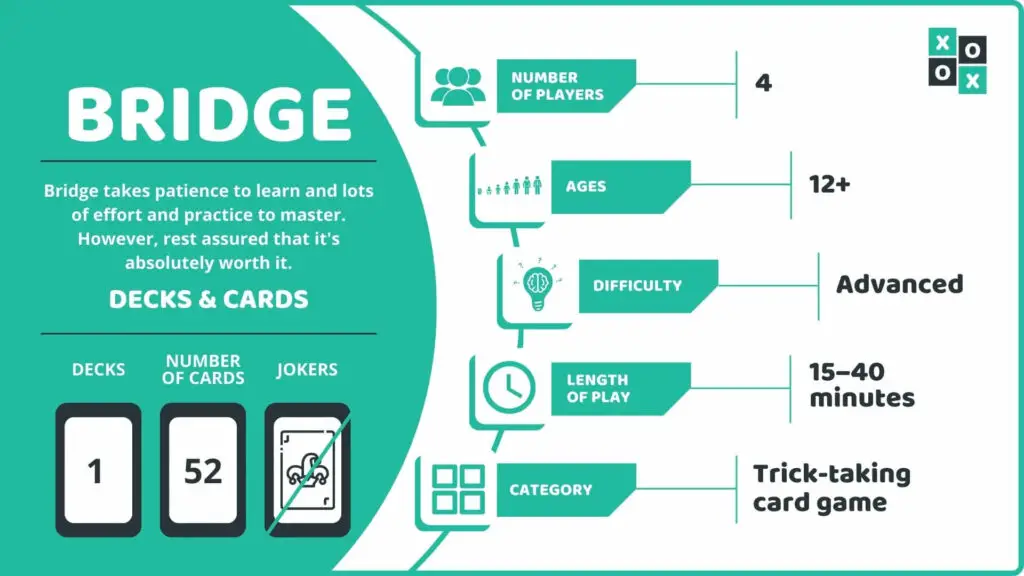
Bridge is a trick-taking card game for four players divided into two teams. One match consists of three games, and each is played over thirteen tricks.
Number of Players: 4
Ages: 12+
Difficulty: Advanced
Length of Play: 15 – 40 minutes
Type of Game: Trick-taking game
Similar to: Whist, Spades, Bridgette
Main Objective: Score the most points through bidding and winning tricks.
Our Take: Bridge takes patience to learn and lots of effort and practice to master. However, rest assured that it’s absolutely worth it.
What You’ll Need to Play Bridge
To play Bridge, ensure you have the following:
- Decks: 1
- Number of Cards: 52
- Cards Omitted: Jokers
Bridge Card Game Rules
There are numerous variations to Bridge. This guide explains how to play Contract Bridge, probably the most common and popular version of this card game.
Starting the Game
The game is played by 4 players who are divided into two teams. The teammates sit across from each other.
The dealer thoroughly shuffles the entire deck of playing cards and deals them all among the players, one card at a time. This means that each player has 13 cards in their hands.
How to Play Bridge
Bridge is a trick-taking card game, meaning the gameplay evolves around playing tricks. Each trick consists of one card from each player, played clockwise.
The winner of the trick is the player who played the highest-ranking card. For the card rank, see the Scoring section below.
Bidding & Trumps
In the beginning, the first player bids on how many tricks their team will win over 6 tricks.
At the same time, they announce their desired trump suit (or “no suit,” meaning there would be no trump in the upcoming round if they won the contract).
Example: Player one announces “2 and spades”, meaning their team will win 2 tricks above 6 (= 8 in total), and their preferred trump suit is spades.
Trump always ranks above the other cards regardless of their rank. But the suits are also ranked from the lowest to the highest (see the Scoring section for details).
Once the first player places their bid, the other players follow. Each new bid, however, has to be higher than the previous one. It can be:
- the same number of tricks in a higher suit, or
- more tricks in any suit
If a player has a weak hand, they can also decide to pass.
The players continue bidding one by one until there are three consecutive passes. The remaining player wins the contract, becoming a declarer.
The declarer’s announced suit becomes the trump suit for the round.
Gameplay
The player to the declarer’s left starts first. They can lead the trick with any card of their choice.
Once the first card is on the table, the declarer’s teammate lays down their cards for everyone to see. This will be the dummy hand.
The declarer will play from both their and their partner’s hand during the upcoming round.
The players must follow the lead suit whenever possible (otherwise, they can play any card). The highest-ranking card/trump wins the trick, and the winner immediately leads a new trick.
The round ends when all 13 tricks are played. The teams count the tricks they won together and compare them to the initial bidding to calculate the score.
Bridge Scoring
Scoring is the most important and complex part of the Bridge card game. If you’re new to this game, having a scoring cheat sheet at hand is a good idea.
The scorecard is divided by a line into two sections:
- below the line (standard points)
- above the line (bonus points)
In any case, only the tricks won above the 6 are worth any points. The number of awarded points depends on the current trump suit:
- Diamonds or clubs: each trick = 20 points
- Spades or hearts: each trick = 30 points
- No trump: 1st trick above 6 = 40 points; each additional trick = 30 points
A game of Bridge is won by earning 100 points. If one of the teams wins the game, draw a line under the score on your scorecard to indicate that the game has been won.
One Bridge match consists of 3 games. When one of the teams wins 2 out of 3 games, the match is over.
The winner, however, is the team with the highest score, including the bonuses and penalties (see below).
Bonus Points & Penalties
Bonus points and penalties are recorded above the line on your scorecard. They mark the positive or negative points awarded for winning more or fewer tricks than the team bid.
Again, the score depends on the current trump suit:
- Diamonds or clubs: each trick = 20 points
- No trump, spades, or hearts: each trick = 30 points
Bonus points are also awarded for winning a match, depending on the actual outcome:
- 2:0 games won: 700 points
- 2:1 games won: 500 points
Team Status
To make it all even more intricate, scoring also depends on the current status of your team.
Each team begins the match as non-vulnerable. After winning one game, they become vulnerable. A vulnerable team gets both higher bonuses and penalties.
If a team bids 6 tricks (= to win 12 tricks) in any trump suit or no trump game, this is known as a small slam. Winning a small slam will get the team:
- 500 points with a non-vulnerable status
- 750 points with a vulnerable status
If a team bids 7 tricks (= to win all 13 tricks) in any trump suit or no trump game, this is known as a grand slam. Winning a grand slam will get the team:
- 1000 points with a non-vulnerable status
- 1500 points with a vulnerable status
Penalty
If a team fails to meet its initial bid, it incurs a penalty depending on its status and the number of tricks under the bid:
- 100 points per trick with a non-vulnerable status
- 50 points per trick with a vulnerable status
Penalty points are not divided from the penalized team’s score but added to their opponents’ score (above the line).
Double & Re-double
At the beginning of the game, any player can announce the double, which increases both the penalties and the bonus points.
In this case, any additional tricks above the bid are worth the following:
- 100 points with a non-vulnerable status
- 200 points per trick with a vulnerable status
…and penalties are:
- 100 points per first and 200 for any additional tricks under the bid with a non-vulnerable status
- 200 points per first and 300 for any additional tricks under the bid with a vulnerable status
The opposing team can also re-double, doubling all the above bonuses and penalties.
Note: If there’s any new bid after the double is announced, the double is canceled.
If the opposing team wins the game, your points do not roll over to the next game. They do count, however, when you’re adding up points for the total match score.
Card Rank
In Bridge, cards are ranked from the highest to the lowest as follows:
- A, K, Q, J, 10, 9, 8, 7, 6, 5, 4, 3, 2.
Of course, don’t forget that the trump suit always outweighs any other cards in the game.
Suit Rank
Suits in Bridge are ranked (low to high) as follows:
- Clubs, diamonds, hearts, spades, no trump (see no-trump round above).
Bridge Card Game Rules in Pictures
Step 1

The game is played by 4 players divided into two opposing teams. Teammates sit across from each other. Each player gets 13 cards.
Step 2
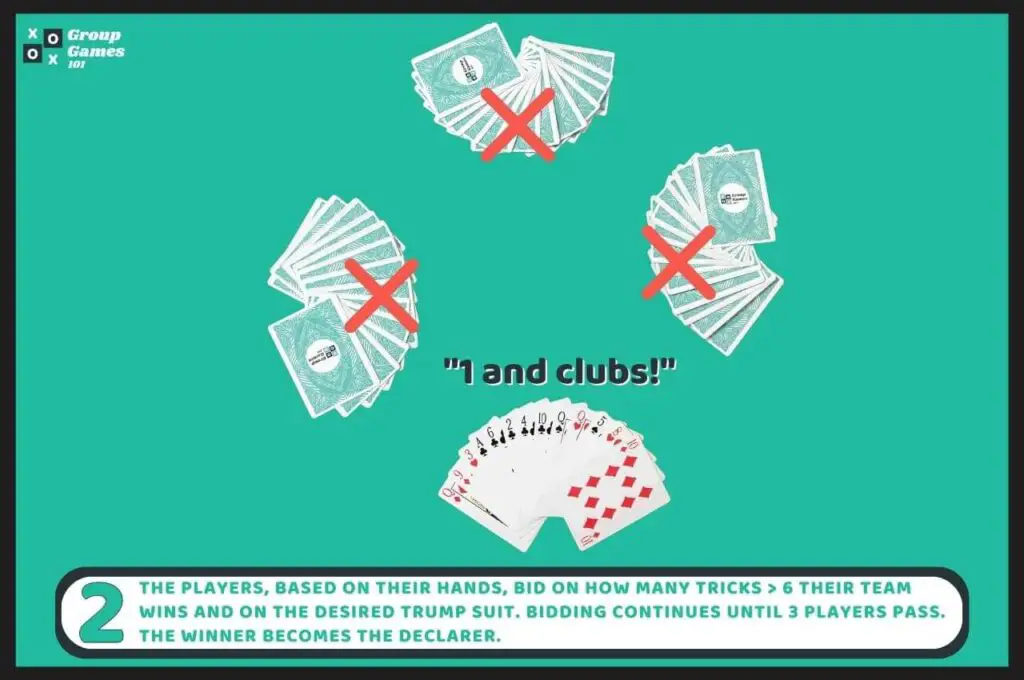
The players, based on their hands, bid on how many tricks > 6 their team wins and on the desired trump suit. Bidding continues until 3 players pass. The winner becomes the declarer.
Step 3
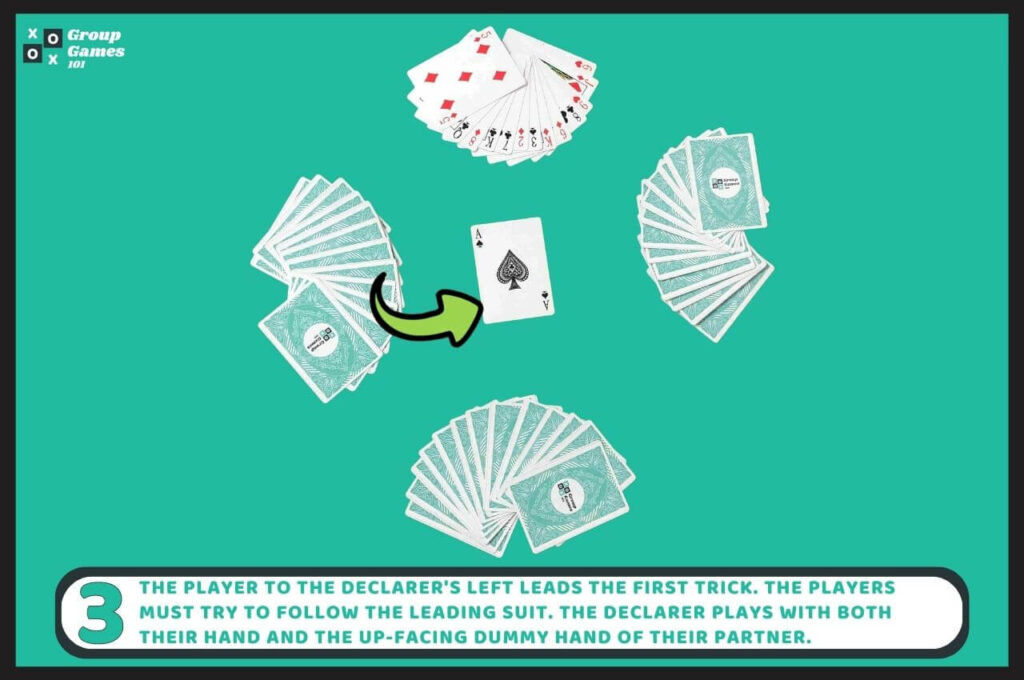
The player to the declarer’s left leads the first trick. The players must try to follow the leading suit. The declarer plays with both their hand and the up-facing dummy hand of their partner.
Step 4
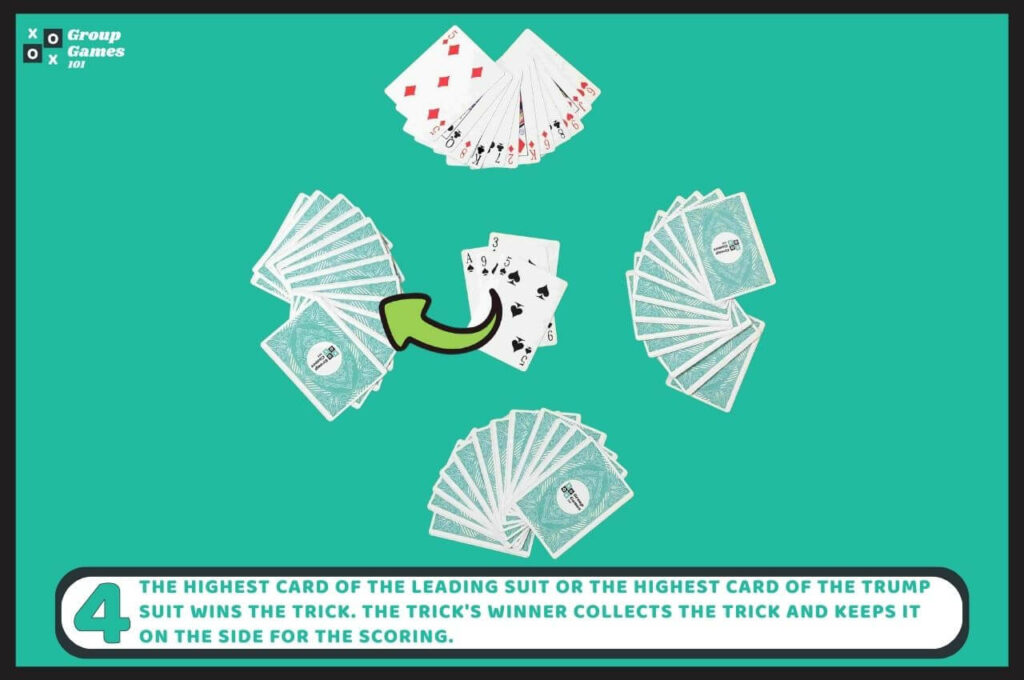
The highest card of the leading suit OR the highest card of the trump suit wins the trick. The trick’s winner collects the trick and keeps it on the side for the scoring.
Step 5
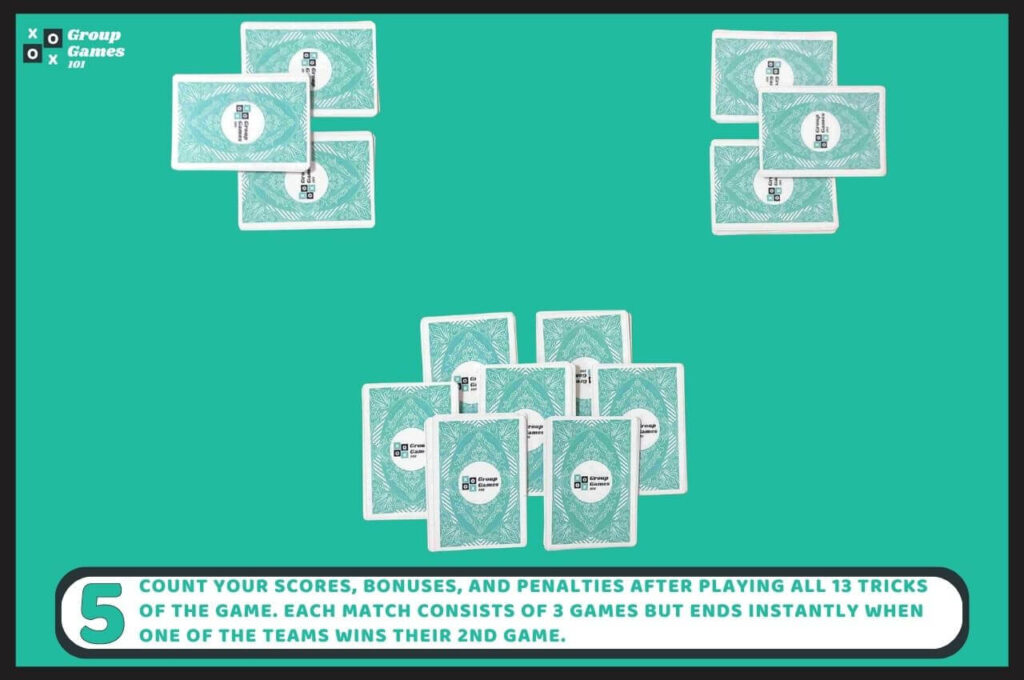
Count your scores, bonuses, and penalties after playing all 13 tricks of the game. Each match consists of 3 games but ends instantly when one of the teams wins their 2nd game.
How to Play Bridge – Video Tutorial
Frequently Asked Questions
Is Bridge an old-people game?
Bridge is sometimes called an old-people game because it’s particularly popular in retirement facilities. Nevertheless, this game is played by all age groups worldwide.
How long does it take to learn the Bridge card game?
Most people can learn to play Bridge on a non-competitive level over one or two evenings. However, mastering your Bridge skills will definitely take longer – maybe even a lifetime.
Which is harder to learn, Bridge or Chess?
It is difficult to answer whether it’s harder to learn Bridge or Chess, as this is highly individual.
Nevertheless, if you have no prior experience with either, it will probably be easier for you to learn how to play the Bridge card game than the game of Chess.
What is the best Bridge strategy?
The best Bridge strategy that allows you to evaluate whether your hand is worth high bids is assigning each face card a value: Aces are 4, Kings are 3, Queens 2, and Jacks 1.
If your hand’s value is 12 or less, pass the bid. If it’s over 12, bid on winning 1 trick above 6 and the suit that prevails in your hand.
Also, don’t forget to check your partner’s bid. It lets you assess how good cards are in their hands too.
Other Bridge Online Resources
If you’d like to play Bridge competitively and meet many like-minded players, here are a few events and organizations you should check out:
Other Similar Games to Bridge (Our Guides)
If you enjoy playing Bridge, check out our guides to a few similar trick-taking card games:
- Whist card game rules
- Spades card game rules
- Euchre card game
- Briscola rules
- Sheepshead rules
- Pitch card game rules
- Bridgette (guide coming soon)





